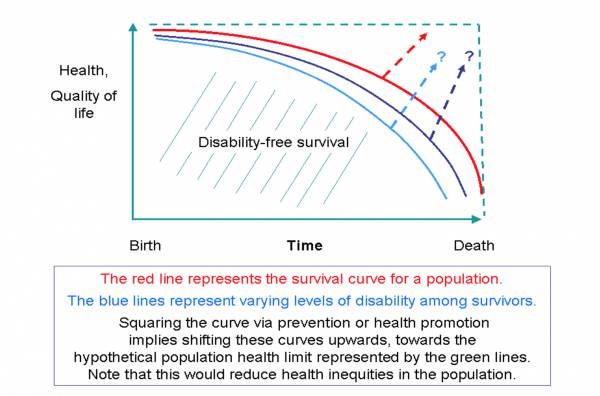“I go to bed healthy and I wake up with an injury.” – Father Time
“I go to bed healthy and I wake up with an injury.” – Father Time
Data now reveals that the majority of health and fitness is within our control, and Canadian research supports the squaring of mortality with healthy lifestyle practice. In my practice, I have found this to be absolutely true. But first, let me tell you about Darrell.
Why Darrell Lost His Groove
At the age of 67 Darrell has a bit of hail damage. Two total shoulder replacements and some arthritis in his knees make the mornings a bit of a challenge. He moves slowly and, while things aren’t perfect, three years ago it was far worse.
Darrell had ignored his roots. He played college football at the highest level, and had practiced everything from bodybuilding to bicycle racing in the years following his career. While things changed with a budding work life and a starting a family, he was still active and exercising.
Then, through years of work, the perception that he was “of age” had become the predominate theme and Darrell had become largely sedentary. Compounding his inactivity was his sloppy diet. The result? Fifty additional pounds of weight and a stiff, unathletic body. Clearly he was heading in the wrong direction that had a disastrous conclusion.
If you examine the passing of time we are, in fact, getting older. Sorry gang. Everything from sex hormones to connective tissue are less abundant and less effective.
The Western Journal of Medicine does not paint a rosy picture when it comes to aging:
“Physiological changes occur with aging in all organ systems. The cardiac output decreases, blood pressure increases and arteriosclerosis develops. The lungs show impaired gas exchange, a decrease in vital capacity and slower expiratory flow rates. The creatinine clearance decreases with age although the serum creatinine level remains relatively constant due to a proportionate age-related decrease in creatinine production. Functional changes, largely related to altered motility patterns, occur in the gastrointestinal system with senescence, and atrophic gastritis and altered hepatic drug metabolism are common in the elderly. Progressive elevation of blood glucose occurs with age on a multifactorial basis and osteoporosis is frequently seen due to a linear decline in bone mass after the fourth decade. The epidermis of the skin atrophies with age and due to changes in collagen and elastin the skin loses its tone and elasticity. Lean body mass declines with age and this is primarily due to loss and atrophy of muscle cells. Degenerative changes occur in many joints and this, combined with the loss of muscle mass, inhibits elderly patients’ locomotion. These changes with age have important practical implications for the clinical management of elderly patients: metabolism is altered, changes in response to commonly used drugs make different drug dosages necessary and there is need for rational preventive programs of diet and exercise in an effort to delay or reverse some of these changes.”
This preview is anything but encouraging. It is easy to see how we might want to throw in the towel. This is old school dogma. The current research paints a much better picture and here is what we now know about aging.
Seventy percent of what happens (healthwise) is under our control.
Let that sink in for a moment. What I am saying is the majority of what happens to us is under our control. If you told me I had a 70% chance of success in anything I’m going to fight you to be first in line. Those, my friend, are winning percentages.
I will concede that while it is not completely understood, aging on its own influences our genes and can trigger nasty things. But the lifestyle choices we make can influence this expression in our genes. The terms of our health, the duration of life, and certainly the quality of life, is driven by our lifestyle.
Canadian researchers found in the longitudinal study that individuals who implemented better health practices lived a longer, higher quality life and had less prolonged passings.

Here is what the study reported in a graphical terms.
The X axis is time to death and the Y axis is health/quality of life. The dotted arrows are lifestyle practice and medical advancements. Instead of a slow bleed to the end, death comes quickly. This squaring of the aging curve allows us to say, “Live long and die short.”
Not All Is Lost
Darrell’s story has a happy ending. Here are just two examples of how he improved his health profile.
Over the initial 12 months, Darrell’s weight went from 311 pounds to 255 pounds. Not only did he lose weight, but performing an up/down (going from a standing position to a prone position on the floor and then back up again) went from 25 seconds to 8 seconds.
This is not an overnight process and there are going to be setbacks, but Darrell’s improvements are not out of the ordinary. Improvements are attainable for all who seek them.
Take Action in the Second Half of Your Life
Welcome to The Second Half Playbook. This section, in cooperation with Pulse Beat Fit, is dedicated to the betterment of the 40-plus athlete.
We are always looking for hacks and practices that allow us to stay in the game of life for as long as possible. Stay tuned as we help bring out the best in you. If you have suggestions for topics that you’d like to see covered please email info@pulsebeatfit.com and put Coach Rut in the subject line.
Continue by reading The Second Half Of Life Playbook: Assess Your Condition.
References:
1. Boss, Gerry R., and J. Edwin Seegmiller. “Age-Related Physiological Changes and Their Clinical Significance.” Western Journal of Medicine 135.6 (1981): 434–440. Print.






